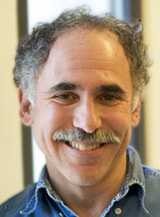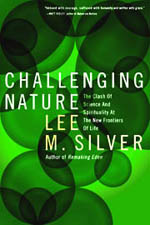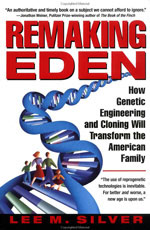|
published by Ecco/Harper Collins, 2006
|
|
Challenging Nature
Previous books
Presentations
Publications/Writings
Biography
Princeton teaching
|
Interview:
Send in the clones The first thing I notice about Lee Silver is that he is short. You may think it is unfair to mention this. After all, he is a molecular biologist at Princeton University, a renowned fertility scientist, the author of a new book about "cloning and beyond". So why do I have to go and mention his height? Because of genes, that's why. Genes are Professor Silver's subject and he points out that he has a few that could be improved on. He has asthma, for instance. And then there is the matter of being 5ft 4in. "It is a fact in America that every inch of height increases your salary," he says. "It's incredible but true." Dr Silver believes that we are not that far from being on the brink of a brave new world of reproductive genetics - or reprogenetics as he calls it - where parents will have the choice whether to pass such things on to their children. "If I could have fixed it so my children didn't have asthma, I would have thought very seriously about that," he says. He asks me what my family disease is and I say cancer. So, he asks, would I use genetic manipulation to reduce the risk of my children getting cancer? Yes, I say without thinking. "Well," he says, "if you can imagine it, it is going to be done. It is a basic instinct for parents to want their children to have all possible advantages. I'm suggesting that our technologies will allow us to get children with, at first, simple traits such as being taller or who are resistant to cancer, or diabetes, or heart disease." I shiver. Dr Silver makes it sound so simple. Too simple perhaps. Things get much more complicated if you think about this for even one more second. Is it immoral to mess around with life in this way? Can the mystery of life be contained in a Petri dish? Is it a sin? Should it be illegal? Dr Silver says that these questions may be very interesting but that they miss an essential point - which is that it will be done. The ethicists are not going to decide this. Nor are governments. "Instead," he says," the marketplace will. There are going to be people who want to use the technology, and it will be available, and the people who want to use it will find others who will take their money. After all, the first basic instinct is to have biological children. The second is to provide your children with all possible advantages." Dr Silver is a scientist who is not afraid of being a science fantasist. He says this is because he has tenure and so can say what he likes. He does not necessarily approve of his brave new world, but he does think it is feasible. He believes, for instance, that there will be human clones, and probably sooner rather than later. He also believes that genetic selection and engineering will be available to parents with enough money to afford it. They will be able to review a selection of their embryos and decide which they want to be their child. And, perhaps scariest of all, they will be able to genetically manipulate embryos. Not only can we lessen the threat of cancer, but we can add a bit of musical ability too. Cloning is going to be better than sex - but only for a few. "The first instance I can think of is a man and a woman who are both sterile," says Dr Silver. "They want a biological child. Anybody who denies the power of this instinct doesn't understand human nature. In America the average amount spent to have a child by in vitro fertilisation is $ 50,000 to $ 60,000. In the case where both are sterile, cloning will be a way to have a biological child." Dr Silver doesn't have a problem with this. He thinks it is amoral not to love a child and isn't that bothered if it's a clone or not. In fact he thinks clones have had a bit of a bad press. I agree. We've all been watching too many movies. "Most people get upset about cloning because they think you can replicate an entire person. People still think this!" This is not true, he says, because a cloned child will be growing up in a different time and place than their parent. Not to mention a different personality and soul. "What I try and tell people is all you are doing is creating a later-born identical twin." The other people who will use cloning are women who would prefer to avoid men and their sperm altogether. This includes lesbian couples and some single women too. "I have a friend. She's 40 and has a seven-year- old from a previous marriage. She wants to have another child but doesn't see why she should use a sperm donor," he says. "She says a sperm donor can bring in all sorts of genetic disease. If cloning becomes available, she would prefer to use that." I ask if his friend is sane. He says that she is perfectly sane, a little negative about men perhaps, but certainly sane. "You know I don't think cloning is so bad. I think it is irrelevant actually. I think it is going to become available some place and I think it will be used by a small percentage of people." I ask when it will happen, if 15 years is reasonable, and he nods. "There will be cloning clinics and people will have children by this technique and nobody would know. The children might just look like them by chance anyway. You might whisper: I wonder if that's a cloned child. Nobody would know." He shakes his head. "Cloning is a sideshow. It doesn't do anything to society. The main theme of my book is reprogenetics. Forget cloning. What will have an effect on society is genetics and making genetic changes in the embryo." So we are back to talking about asthma and height, and Dr Silver starts to talk even faster. He foresees a future where parents with enough money will be able to purchase two types of procedures. The first - which he calls The Virtual Child - involves analysing a batch of your own embryos to decide which one has the best genetic profile. This is an extension of genetic screening which is already done for some diseases. The second type of procedure uses genetic engineering to create a Designer Child. The parents choose which genes to add to their embryo and then it is implanted. "This is the most significant thing that is going to happen to the human race, ever," says Dr Silver. For the first time in our conversation, Dr Silver says that he finds this frightening. He does not know where to draw the line. Which genetic advantages should parents use and how many of them? In the long-term, he says, genetic engineering would do nothing less than split society between the "naturals" and the "GenRich". "I'm ambivalent on this," he says. "On the one hand it's hard to stop parents from giving their children things and so individual use of the technology cannot be condemned and yet the logical outcome of this is a society that is torn apart. I don't have a solution though. My purpose in writing the book is to make people think about it." And so then Dr Silver and I go back to thinking about ourselves and genetic manipulation and our own lives. So, I say as I look down on him, what about the height thing? "In my own case I do think that being short is a disadvantage in life," he says. "I guess if I was selecting embryos for some other reason, I would, but I wouldn't do it just for that." It's a tough call but, aged 45 and with children already, he won't have to make it for real. His children might. Remaking Eden: Cloning and Beyond in a Brave New World by Lee Silver is published by Weidenfeld and Nicolson at pounds 20. |
Hover over or click on books to order from Amazon.com
|


